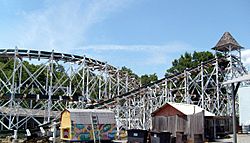Leap-The-Dips facts for kids
- For the former roller-coaster "Leap the Dips" at Cedar Point in Sandusky, Ohio, see List of former Cedar Point attractions.
Quick facts for kids Leap-The-Dips |
|
|---|---|
 |
|
| Lakemont Park | |
| Location | Lakemont Park |
| Coordinates | 40°28′15″N 78°23′48″W / 40.47083°N 78.39667°W |
| Status | Operating |
| Opening date | 1902 |
| General statistics | |
| Type | Wood – Side friction |
| Manufacturer | Federal Construction Company |
| Designer | Edward Joy Morris |
| Height | 41 ft (12 m) |
| Drop | 9 ft (2.7 m) |
| Length | 1,452 ft (443 m) |
| Speed | 10 mph (16 km/h) |
| Duration | 1:00 |
| Max vertical angle | 25° |
| Leap-The-Dips at RCDB | |
|
Leap-the-Dips
|
|
| Location | Logan Township, Blair County, Pennsylvania |
|---|---|
| Built | 1902 |
| Architect | Edward Joy Morris |
| NRHP reference No. | 91000229 |
| Significant dates | |
| Added to NRHP | March 15, 1991 |
| Designated NHL | June 19, 1996 |
Leap-The-Dips is a special wooden roller coaster at Lakemont Park in Altoona, Pennsylvania. It was built in 1902 by the Federal Construction Company. Edward Joy Morris designed this amazing ride.
This roller coaster is the oldest one still working in the whole world! It is also thought to be the very last "side friction" roller coaster with a figure-eight shape. Leap-The-Dips ran for many years until 1985. It closed because it needed a lot of repairs.
People worked hard to save it. They raised money to fix it up. The restoration started in 1997 and finished in 1999. It reopened to the public then. In 1996, it was named a National Historic Landmark. This means it is a very important historical place. It also won awards from American Coaster Enthusiasts.
Contents
History of Leap-The-Dips
Leap-The-Dips was designed by Edward Joy Morris. The Federal Construction Company built it. It first opened at Lakemont Park in 1902. Its figure-eight design was very popular. Many "side friction" roller coasters were built this way. This was especially true in the early 1900s.
This type of roller coaster was most popular in the 1920s. Leap-The-Dips is one of the few from that time that still exists. It is known as the oldest operating roller coaster in the world.
Saving the Roller Coaster
The roller coaster faced tough times around the 1980s. In 1985, it had to close. This was because its wooden structure was getting old. There was not enough money to fix it.
A group called American Coaster Enthusiasts (ACE) started a plan to save it. They formed the Leap The Dips Foundation. This group collected money from people and worked with banks. Their goal was to stop the roller coaster from being torn down.
Restoration work began in 1997. Workers used old carpentry methods, just like when it was first built. Over 70% of the original wood was kept. Leap-The-Dips officially reopened on May 31, 1999.
Awards and Recognition
Before it was fixed, Leap-The-Dips was added to the National Register of Historic Places in 1993. This list includes important places in history. A few years later, in 1996, it became a National Historic Landmark.
After it reopened, ACE gave Leap-The-Dips two special awards. These were the Coaster Landmark Award and the Coaster Classic Award. In 2017, Lakemont Park announced big plans. The park would close for a year to get a full makeover. It stayed closed in 2018 too. The park planned to reopen in 2019 as a "family entertainment location."
How Leap-The-Dips Works
Leap-The-Dips is located in a rectangular area at Lakemont Park. This area is about 84 feet by 229 feet (26 by 70 meters). The track is shaped like a figure-eight. It sits on wooden supports called trestles.
The place where you get on and off the ride is an open station. It has a hipped roof. The ride cars are stored in a nearby shed. The track's shape has not changed much since it was built. Most of the track is wood. Some parts that wear out quickly have been replaced with steel. The lift chain, which pulls the cars up, is also now made of steel.
Safety Features
The lift system has a special ratchet. This stops the cars from rolling backward. It is a safety feature in case the chain breaks. The ride cars look like sleighs. They have four wheels underneath. They also have two extra wheels on each side.
The track goes around the figure-eight shape two and a half times. It passes through the wooden supports at different levels. This ride is not as fast or tall as modern roller coasters. It is 41 feet (12 meters) high and goes about 10 miles per hour (16 km/h). But it is still a very popular ride.
Side Friction Design
Side friction roller coasters were an early type of roller coaster. They allowed rides to go faster. They also did not need a person to control the brakes. These coasters had extra wheels on the sides of the cars. These wheels helped guide the cars on the track.
This design became less common after World War I. Newer roller coasters used different ways to hold the cars. These new designs were safer and allowed for even faster speeds.
Very few side friction roller coasters lasted until the 1980s. Leap-The-Dips at Lakemont Park is believed to be the last one of its kind. It is the only remaining figure-eight model still running. There was once an identical ride at Mounds State Park in Indiana. But that amusement park closed in the 1920s.




